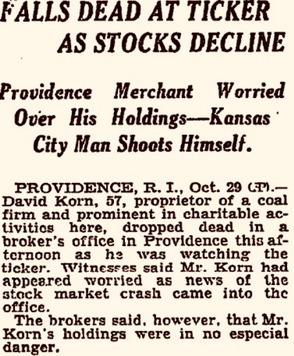Causes of the Stock Market Crash
The Buildup
Many theories exist on what caused the worst economic depression in recent history; though scholars congregate around several reasons, there hasn’t been a consensus on a single culprit. The Keynesian school of thought argues that a drop in aggregate demand, the collective spending of goods and services, is to blame. The Monetarist view, on the other hand, claims that the Federal Reserve's decision to shrink the money supply exacerbated the economic turmoil. Another explanation is Irving Fischer's theory involving debt deflation, which describes a phenomenon where over-indebtness leads to series of events that result in a widespread fall in profits.
During the 1920s, while several troubling events were brewing, like record-high national debt and deflation, government leaders seemed to turn a blind eye to these economic concerns. In this political ad, Herbert Hoover says very little about the economic situation in America, rather focusing on the superiority of his political party. However, this myopic optimism wasn't unique to Hoover; throughout the Great Depression, many people in power exhibited a blindness to the economy's impliciations on marginalized people, which this exhibit aims to display.
The Climax
The aforementioned events culminated in what is widely known as Black Monday, the first economic plunge in the Wall Street Crash of 1929. On October 24, 1929, the Dow Jones Industrial Average plumetted 13%. A series of crashes ensued in the following month, resulting in the Dow Jones losing nearly half its value by November.
In this newsreel from 1929, at B.C. Forbes advises citizens to buy more stock.
However optimistic Forbes' conviction seems, the unrelenting series of crashes in the following years suggest that it is more than a simple recession. From this point to 1932, the Dow went on to lose 89.2% of its value. Hoover’s presidency reaches an end in 1933, at the height of the depression; 24.9% of the workforce was unemployed.
Yet, Hoover's indifference to these events is seen in his letter to Bruce Barton, a Republican businessman and politician. Even in his retirement, Hoover expresses great concern in the political leaning of his country, but not the unprecedented levels of unemployment. Instead, he discusses his hobbies of smoking pipes and fishing.
The Fallout
All the misfortunes the stock market crash caused in American lives cannot be described within the scope of this section. However, one example of how the crash translated to worsened lifestyles (aside from the record-high unmployment rate) is the widespread bank failures. As of 1933, deposits in failed banks peaked at a staggering $7 billion. Of course, there were many other ills inflicted on normal American lives, such as a widespread housing crash, decrease in wages, and extreme deflation. For a decade, the American working and middle class inevitably battled this unforseen depression, all while their leaders seem to betlittle the severity of it. The narratives of these people cannot be expressed briefly, but this letter offers a glimpse into the misery of an average citizen at that time.
Further Reading
To learn more about the debate behind what caused the Great Depression, check out this episode from the American History Teller's podcast:
https://podcasts.apple.com/us/podcast/the-great-depression-the-crash/id1313596069?i=1000430234880




